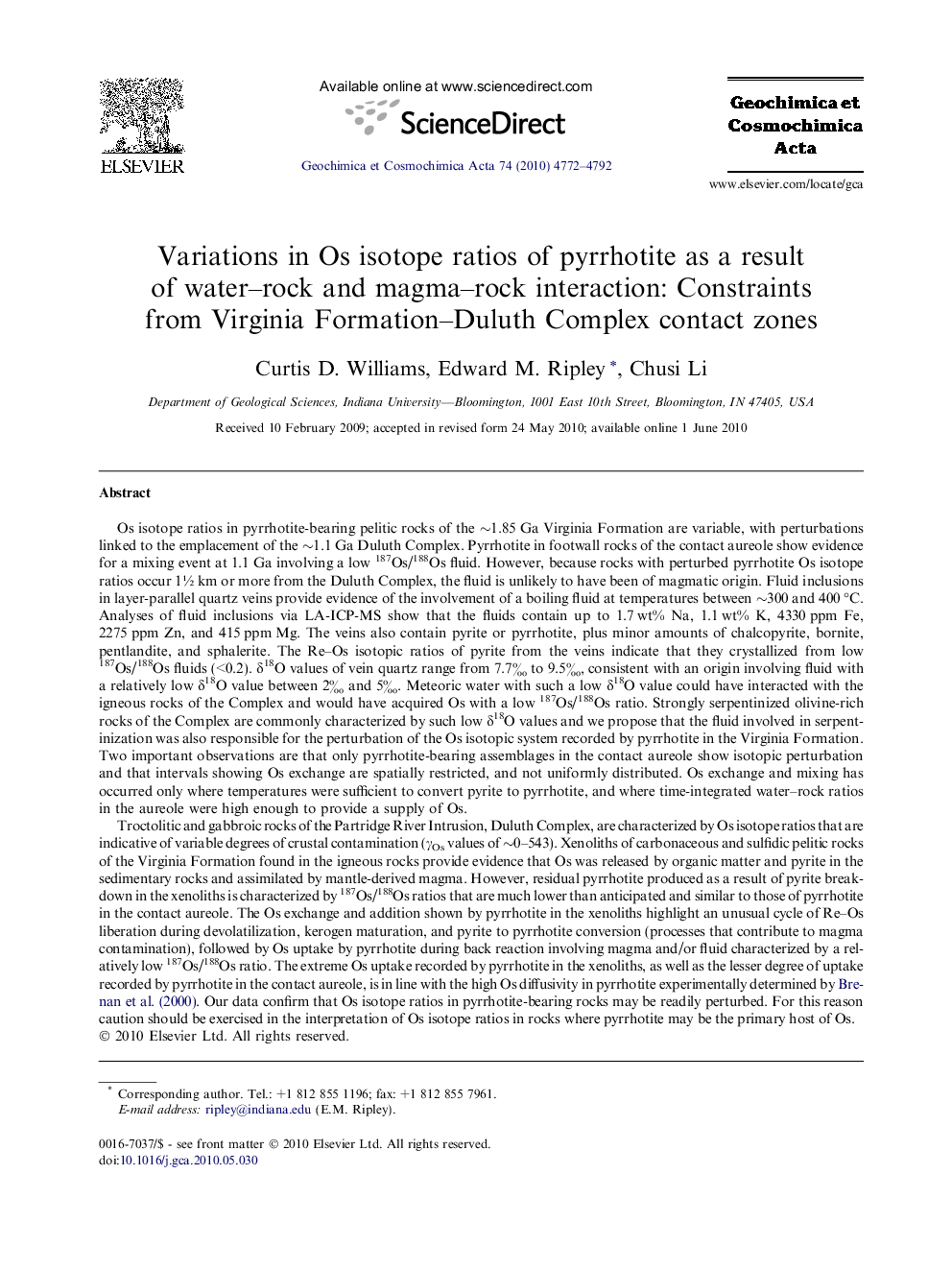| کد مقاله | کد نشریه | سال انتشار | مقاله انگلیسی | نسخه تمام متن |
|---|---|---|---|---|
| 4703894 | 1352885 | 2010 | 21 صفحه PDF | دانلود رایگان |

Os isotope ratios in pyrrhotite-bearing pelitic rocks of the ∼1.85 Ga Virginia Formation are variable, with perturbations linked to the emplacement of the ∼1.1 Ga Duluth Complex. Pyrrhotite in footwall rocks of the contact aureole show evidence for a mixing event at 1.1 Ga involving a low 187Os/188Os fluid. However, because rocks with perturbed pyrrhotite Os isotope ratios occur 1½ km or more from the Duluth Complex, the fluid is unlikely to have been of magmatic origin. Fluid inclusions in layer-parallel quartz veins provide evidence of the involvement of a boiling fluid at temperatures between ∼300 and 400 °C. Analyses of fluid inclusions via LA-ICP-MS show that the fluids contain up to 1.7 wt% Na, 1.1 wt% K, 4330 ppm Fe, 2275 ppm Zn, and 415 ppm Mg. The veins also contain pyrite or pyrrhotite, plus minor amounts of chalcopyrite, bornite, pentlandite, and sphalerite. The Re–Os isotopic ratios of pyrite from the veins indicate that they crystallized from low 187Os/188Os fluids (<0.2). δ18O values of vein quartz range from 7.7‰ to 9.5‰, consistent with an origin involving fluid with a relatively low δ18O value between 2‰ and 5‰. Meteoric water with such a low δ18O value could have interacted with the igneous rocks of the Complex and would have acquired Os with a low 187Os/188Os ratio. Strongly serpentinized olivine-rich rocks of the Complex are commonly characterized by such low δ18O values and we propose that the fluid involved in serpentinization was also responsible for the perturbation of the Os isotopic system recorded by pyrrhotite in the Virginia Formation. Two important observations are that only pyrrhotite-bearing assemblages in the contact aureole show isotopic perturbation and that intervals showing Os exchange are spatially restricted, and not uniformly distributed. Os exchange and mixing has occurred only where temperatures were sufficient to convert pyrite to pyrrhotite, and where time-integrated water–rock ratios in the aureole were high enough to provide a supply of Os.Troctolitic and gabbroic rocks of the Partridge River Intrusion, Duluth Complex, are characterized by Os isotope ratios that are indicative of variable degrees of crustal contamination (γOs values of ∼0–543). Xenoliths of carbonaceous and sulfidic pelitic rocks of the Virginia Formation found in the igneous rocks provide evidence that Os was released by organic matter and pyrite in the sedimentary rocks and assimilated by mantle-derived magma. However, residual pyrrhotite produced as a result of pyrite breakdown in the xenoliths is characterized by 187Os/188Os ratios that are much lower than anticipated and similar to those of pyrrhotite in the contact aureole. The Os exchange and addition shown by pyrrhotite in the xenoliths highlight an unusual cycle of Re–Os liberation during devolatilization, kerogen maturation, and pyrite to pyrrhotite conversion (processes that contribute to magma contamination), followed by Os uptake by pyrrhotite during back reaction involving magma and/or fluid characterized by a relatively low 187Os/188Os ratio. The extreme Os uptake recorded by pyrrhotite in the xenoliths, as well as the lesser degree of uptake recorded by pyrrhotite in the contact aureole, is in line with the high Os diffusivity in pyrrhotite experimentally determined by Brenan et al. (2000). Our data confirm that Os isotope ratios in pyrrhotite-bearing rocks may be readily perturbed. For this reason caution should be exercised in the interpretation of Os isotope ratios in rocks where pyrrhotite may be the primary host of Os.
Journal: Geochimica et Cosmochimica Acta - Volume 74, Issue 16, 15 August 2010, Pages 4772–4792